
Scintillons are small structures in cytoplasm that produce light. Among bioluminescent organisms, only dinoflagellates have scintillons.

Scintillons are small structures in cytoplasm that produce light. Among bioluminescent organisms, only dinoflagellates have scintillons.
Marine dinoflagellates at night can emit blue light by bioluminescence, a process also called "the phosphorescence of the seas". Light production in these single celled organisms is produced by small structures in the cytoplasm called scintillons. Among bioluminescent organisms, only dinoflagellates have scintillons. In the dinoflagellates, the biochemical reaction that produces light involves a luciferase-catalysed oxidation of a linear tetrapyrrole called luciferin. [1] The dinoflagellate Lingulodinium polyedra (previously called Gonyaulax polyedra) also contains a second protein called luciferin binding protein (LBP) [2] that has been proposed to protect luciferin from non-luminescent oxidation. Luciferin is released from LBP by a decrease in pH, and the same decreased pH also activates the luciferase. [3] Light production in the dinoflagellates occurs in bioluminescent organelles called scintillons and can be stimulated by agitation of the surrounding seawater.
The name scintillon was first used to describe cytoplasmic particles isolated from a bioluminescent species of dinoflagellate that were able to produce a flash of light in response to a decrease in pH. [4] Scintillons were first observed in L. polyedra by fluorescence microscopy, [5] where they appear as small blue dots close to the cell surface. This blue fluorescence is due to the presence of the bioluminescence reaction substrate, a naturally fluorescent molecule called luciferin. [6] When light production is stimulated by addition of dilute acid to the cells under the microscope, the site of light production corresponds to the location of the scintillons. Furthermore, the natural luciferin fluorescence is reduced after the light producing reaction. [5]
Cells observed under the electron microscope after a technique involving rapid freezing of the cells followed by substitution of water with a polymer (Fast-freeze Fixation/Freeze Substitution) contain a large number of electron dense bodies around the cell periphery. [7] These structures correspond in size and location to the fluorescent bodies confirmed to be scintillons by their light emission, and they show colocalization of anti-luciferase and anti-LBP labeling meaning both bioluminescence proteins are found in the structures. [8] Scintillons appear as cytoplasmic drops hanging in the vacuolar space, as they are almost completely surrounded by the vacuolar membrane. This structure led to the proposal that a voltage gated proton channel in the vacuolar membrane could allow an action potential to be propagated along the vacuolar membrane. [7] This would in turn let protons enter into the cytoplasm around all the scintillons in the cells virtually simultaneously producing an intense but brief flash of light. Voltage gated proton channels were subsequently identified in a dinoflagellate confirming their predicted existence. [9]
Scintillons have been extensively purified from L. polyedra by centrifugation, and these purified scintillon preparations contain luciferase and luciferin binding protein as the only detectable protein components. [10] The amount of luciferase, [11] LBP [12] and luciferin [13] all vary over the course of a daily (circadian) period, as do the number of scintillons in the cell. [14] These observations suggest that the circadian control of bioluminescence involves a daily synthesis and degradation of luciferase and LBP. When synthesized, these two proteins aggregate together and migrate to the vacuole membrane where LBP binds luciferin and the scintillons acquires an ability to produce light upon stimulation.
Scintillons are not identical in different species. Scintillons isolated from dinoflagellates belonging to the genus Pyrocystis such as P. lunula (previously Dissodinium lunula) or P. noctiluca are less dense than those of L. polyedra and do not contain LBP. [15] Little is known about the structure or composition of scintillons in species other than L. polyedra.
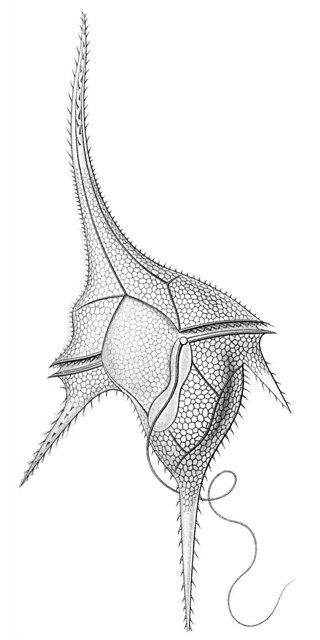
The dinoflagellates are a monophyletic group of single-celled eukaryotes constituting the phylum Dinoflagellata and are usually considered algae. Dinoflagellates are mostly marine plankton, but they also are common in freshwater habitats. Their populations vary with sea surface temperature, salinity, and depth. Many dinoflagellates are photosynthetic, but a large fraction of these are in fact mixotrophic, combining photosynthesis with ingestion of prey.

Bioluminescence is the production and emission of light by living organisms. It is a form of chemiluminescence. Bioluminescence occurs widely in marine vertebrates and invertebrates, as well as in some fungi, microorganisms including some bioluminescent bacteria, and terrestrial arthropods such as fireflies. In some animals, the light is bacteriogenic, produced by symbiotic bacteria such as those from the genus Vibrio; in others, it is autogenic, produced by the animals themselves.

Luciferase is a generic term for the class of oxidative enzymes that produce bioluminescence, and is usually distinguished from a photoprotein. The name was first used by Raphaël Dubois who invented the words luciferin and luciferase, for the substrate and enzyme, respectively. Both words are derived from the Latin word lucifer, meaning "lightbearer", which in turn is derived from the Latin words for "light" (lux) and "to bring or carry" (ferre).

A railroad worm is a larva or larviform female adult of a beetle of the genus Phrixothrix in the family Phengodidae, characterized by the possession of two different colors of bioluminescence. It has the appearance of a caterpillar. The eleven pairs of luminescent organs on their second thoracic segment through their ninth abdominal segment can glow yellowish-green, while the pair on their head can glow red; this is due to different luciferases in their bodies, as the reaction substrate, called luciferin, is the same.

Luciferin is a generic term for the light-emitting compound found in organisms that generate bioluminescence. Luciferins typically undergo an enzyme-catalyzed reaction with molecular oxygen. The resulting transformation, which usually involves splitting off a molecular fragment, produces an excited state intermediate that emits light upon decaying to its ground state. The term may refer to molecules that are substrates for both luciferases and photoproteins.

Noctiluca scintillans is a marine species of dinoflagellate that can exist in a green or red form, depending on the pigmentation in its vacuoles. It can be found worldwide, but its geographical distribution varies depending on whether it is green or red. This unicellular microorganism is known for its ability to bioluminesce, giving the water a bright blue glow seen at night. However, blooms of this species can be responsible for environmental hazards, such as toxic red tides. They may also be an indicator of anthropogenic eutrophication.
Luminescent bacteria emit light as the result of a chemical reaction during which chemical energy is converted to light energy. Luminescent bacteria exist as symbiotic organisms carried within a larger organism, such as many deep sea organisms, including the Lantern Fish, the Angler fish, certain jellyfish, certain clams and the Gulper eel. The light is generated by an enzyme-catalyzed chemoluminescence reaction, wherein the pigment luciferin is oxidised by the enzyme luciferase. The expression of genes related to bioluminescence is controlled by an operon called the lux operon.

Firefly luciferin is the luciferin, or light-emitting compound, used for the firefly (Lampyridae), railroad worm (Phengodidae), starworm (Rhagophthalmidae), and click-beetle (Pyrophorini) bioluminescent systems. It is the substrate of luciferase, which is responsible for the characteristic yellow light emission from many firefly species.
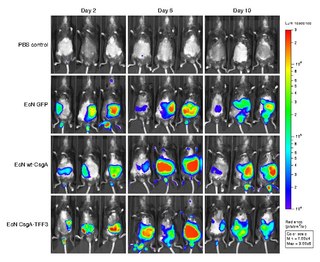
Bioluminescence imaging (BLI) is a technology developed over the past decade that allows for the noninvasive study of ongoing biological processes. Recently, bioluminescence tomography (BLT) has become possible and several systems have become commercially available. In 2011, PerkinElmer acquired one of the most popular lines of optical imaging systems with bioluminescence from Caliper Life Sciences.
A photocyte is a cell that specializes in catalyzing enzymes to produce light (bioluminescence). Photocytes typically occur in select layers of epithelial tissue, functioning singly or in a group, or as part of a larger apparatus. They contain special structures termed as photocyte granules. These specialized cells are found in a range of multicellular animals including ctenophora, coelenterates (cnidaria), annelids, arthropoda and fishes. Although some fungi are bioluminescent, they do not have such specialized cells.

Pyrocystis fusiformis is a non-motile, tropical, epipelagic, marine dinoflagellate, reaching lengths of up to 1 mm. P. fusiformis display bioluminescence when disturbed or agitated. In coastal marine waters, this dinoflagellate causes glowing effects after dark. P. fusiformis was first described in the Proceedings of the Royal Society of London in 1876.
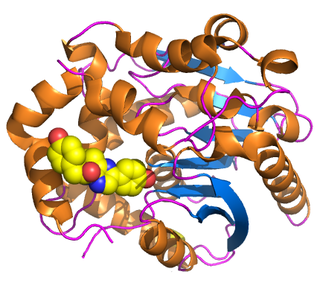
Renilla-luciferin 2-monooxygenase, Renilla luciferase, or RLuc, is a bioluminescent enzyme found in Renilla reniformis, belonging to a group of coelenterazine luciferases. Of this group of enzymes, the luciferase from Renilla reniformis has been the most extensively studied, and due to its bioluminescence requiring only molecular oxygen, has a wide range of applications, with uses as a reporter gene probe in cell culture, in vivo imaging, and various other areas of biological research. Recently, chimeras of RLuc have been developed and demonstrated to be the brightest luminescent proteins to date, and have proved effective in both noninvasive single-cell and whole body imaging.
Photoproteins are a type of enzyme, made of protein, from bioluminescent organisms. They add to the function of the luciferins whose usual light-producing reaction is catalyzed by the enzyme luciferase.
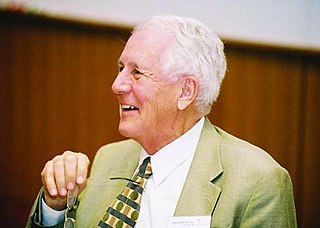
John Woodland "Woody" Hastings, was a leader in the field of photobiology, especially bioluminescence, and was one of the founders of the field of circadian biology. He was the Paul C. Mangelsdorf Professor of Natural Sciences and Professor of Molecular and Cellular Biology at Harvard University. He published over 400 papers and co-edited three books.
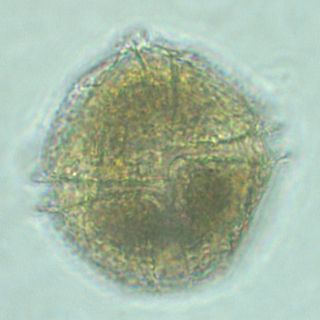
Lingulodinium polyedra is a species of motile photosynthetic dinoflagellates. L. polyedra are often the cause of red tides in southern California, leading to bioluminescent displays on beaches at night.
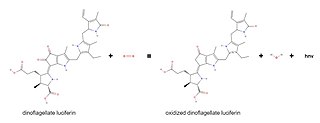
Dinoflagellate luciferase (EC 1.13.12.18, Gonyaulax luciferase) is a specific luciferase, an enzyme with systematic name dinoflagellate-luciferin:oxygen 132-oxidoreductase.
Eleanor Beatrice Marcy "Beazy" Sweeney was an American plant physiologist and a pioneering investigator into circadian rhythms. At the time of her death she was professor emerita at the University of California, Santa Barbara, where she had worked since 1961.

Bioluminescent bacteria are light-producing bacteria that are predominantly present in sea water, marine sediments, the surface of decomposing fish and in the gut of marine animals. While not as common, bacterial bioluminescence is also found in terrestrial and freshwater bacteria. These bacteria may be free living or in symbiosis with animals such as the Hawaiian Bobtail squid or terrestrial nematodes. The host organisms provide these bacteria a safe home and sufficient nutrition. In exchange, the hosts use the light produced by the bacteria for camouflage, prey and/or mate attraction. Bioluminescent bacteria have evolved symbiotic relationships with other organisms in which both participants benefit close to equally. Another possible reason bacteria use luminescence reaction is for quorum sensing, an ability to regulate gene expression in response to bacterial cell density.

Carl Hirschie Johnson is an American-born biologist who researches the chronobiology of different organisms, most notably the bacterial circadian rhythms of cyanobacteria. Johnson completed his undergraduate degree in Honors Liberal Arts at the University of Texas at Austin, and later earned his PhD in biology from Stanford University, where he began his research under the mentorship of Dr. Colin Pittendrigh. Currently, Johnson is the Stevenson Professor of Biological Sciences at Vanderbilt University.
Jay Dunlap is an American chronobiologist and photobiologist who has made significant contributions to the field of chronobiology by investigating the underlying mechanisms of circadian systems in Neurospora, a fungus commonly used as a model organism in biology, and in mice and mammalian cell culture models. Major contributions by Jay Dunlap include his work investigating the role of frq and wc clock genes in circadian rhythmicity, and his leadership in coordinating the whole genome knockout collection for Neurospora. He is currently the Nathan Smith Professor of Molecular and Systems Biology at the Geisel School of Medicine at Dartmouth. He and his colleague Jennifer Loros have mentored numerous students and postdoctoral fellows, many of whom presently hold positions at various academic institutions.